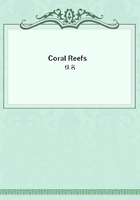
第32章
The apparently capricious distribution, therefore, of coral-reefs, cannot be explained by any of these obvious causes; but as the study of the terrestrial and better known half of the world must convince every one that no station capable of supporting life is lost,--nay more, that there is a struggle for each station, between the different orders of nature,--we may conclude that in those parts of the intertropical sea, in which there are no coral-reefs, there are other organic bodies supplying the place of the reef-building polypifers. It has been shown in the chapter on Keeling atoll that there are some species of large fish, and the whole tribe of Holothuriae which prey on the tenderer parts of the corals. On the other hand, the polypifers in their turn must prey on some other organic beings; the decrease of which from any cause would cause a proportionate destruction of the living coral. The relations, therefore, which determine the formation of reefs on any shore, by the vigorous growth of the efficient kinds of coral, must be very complex, and with our imperfect knowledge quite inexplicable. From these considerations, we may infer that changes in the condition of the sea, not obvious to our senses, might destroy all the coral-reefs in one area, and cause them to appear in another: thus, the Pacific or Indian Ocean might become as barren of coral-reefs as the Atlantic now is, without our being able to assign any adequate cause for such a change.
It has been a question with some naturalists, which part of a reef is most favourable to the growth of coral. The great mounds of living Porites and of Millepora round Keeling atoll occur exclusively on the extreme verge of the reef, which is washed by a constant succession of breakers; and living coral nowhere else forms solid masses. At the Marshall islands the larger kinds of coral (chiefly species of Astraea, a genus closely allied to Porites) "which form rocks measuring several fathoms in thickness," prefer, according to Chamisso (Kotzebue's "First Voyage" (English Translation), volume iii., pages 142, 143, 331.), the most violent surf. I have stated that the outer margin of the Maldiva atolls consists of living corals (some of which, if not all, are of the same species with those at Keeling atoll), and here the surf is so tremendous, that even large ships have been thrown, by a single heave of the sea, high and dry on the reef, all on board thus escaping with their lives.
Ehrenberg (Ehrenberg, "Uber die Natur und Bildung der Corallen Banke im rothen Meere," page 49.) remarks, that in the Red Sea the strongest corals live on the outer reefs, and appear to love the surf; he adds, that the more branched kinds abound a little way within, but that even these in still more protected places, become smaller. Many other facts having a similar tendency might be adduced. (In the West Indies, as I am informed by Captain Bird Allen, R.N., it is the common belief of those, who are best acquainted with the reefs, that the coral flourishes most, where freely exposed to the swell of the open sea.) It has, however, been doubted by MM. Quoy and Gaimard, whether any kind of coral can even withstand, much less flourish in, the breakers of an open sea ("Annales des Sciences Naturelles," tome vi., pages 276, 278.--"La ou les ondes sont agitees, les Lytophytes ne peuvent travailler, parce qu'elles detruiraient leurs fragiles edifices," etc.): they affirm that the saxigenous lithophytes flourish only where the water is tranquil, and the heat intense. This statement has passed from one geological work to another; nevertheless, the protection of the whole reef undoubtedly is due to those kinds of coral, which cannot exist in the situations thought by these naturalists to be most favourable to them. For should the outer and living margin perish, of any one of the many low coral-islands, round which a line of great breakers is incessantly foaming, the whole, it is scarcely possible to doubt, would be washed away and destroyed, in less than half a century. But the vital energies of the corals conquer the mechanical power of the waves; and the large fragments of reef torn up by every storm, are replaced by the slow but steady growth of the innumerable polypifers, which form the living zone on its outer edge.
From these facts, it is certain, that the strongest and most massive corals flourish, where most exposed. The less perfect state of the reef of most atolls on the leeward and less exposed side, compared with its state to windward; and the analogous case of the greater number of breaches on the near sides of those atolls in the Maldiva Archipelago, which afford some protection to each other, are obviously explained by this circumstance. If the question had been, under what conditions the greater number of species of coral, not regarding their bulk and strength, were developed, I should answer,--probably in the situations described by MM. Quoy and Gaimard, where the water is tranquil and the heat intense. The total number of species of coral in the circumtropical seas must be very great: in the Red Sea alone, 120 kinds, according to Ehrenberg (Ehrenberg, "Uber die Natur," etc., etc., page 46.), have been observed.